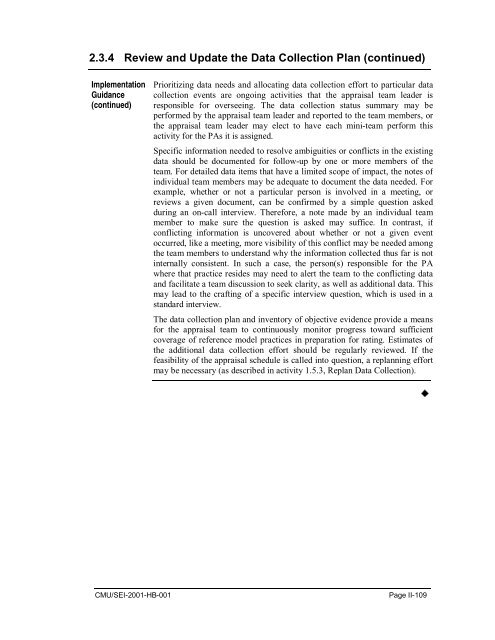Standard CMMI Appraisal Method for Process Improvement (SCAMPI)
Standard CMMI Appraisal Method for Process Improvement (SCAMPI)
Standard CMMI Appraisal Method for Process Improvement (SCAMPI)
Create successful ePaper yourself
Turn your PDF publications into a flip-book with our unique Google optimized e-Paper software.
2.3.4 Review and Update the Data Collection Plan (continued)<br />
Implementation<br />
Guidance<br />
(continued)<br />
Prioritizing data needs and allocating data collection ef<strong>for</strong>t to particular data<br />
collection events are ongoing activities that the appraisal team leader is<br />
responsible <strong>for</strong> overseeing. The data collection status summary may be<br />
per<strong>for</strong>med by the appraisal team leader and reported to the team members, or<br />
the appraisal team leader may elect to have each mini-team per<strong>for</strong>m this<br />
activity <strong>for</strong> the PAs it is assigned.<br />
Specific in<strong>for</strong>mation needed to resolve ambiguities or conflicts in the existing<br />
data should be documented <strong>for</strong> follow-up by one or more members of the<br />
team. For detailed data items that have a limited scope of impact, the notes of<br />
individual team members may be adequate to document the data needed. For<br />
example, whether or not a particular person is involved in a meeting, or<br />
reviews a given document, can be confirmed by a simple question asked<br />
during an on-call interview. There<strong>for</strong>e, a note made by an individual team<br />
member to make sure the question is asked may suffice. In contrast, if<br />
conflicting in<strong>for</strong>mation is uncovered about whether or not a given event<br />
occurred, like a meeting, more visibility of this conflict may be needed among<br />
the team members to understand why the in<strong>for</strong>mation collected thus far is not<br />
internally consistent. In such a case, the person(s) responsible <strong>for</strong> the PA<br />
where that practice resides may need to alert the team to the conflicting data<br />
and facilitate a team discussion to seek clarity, as well as additional data. This<br />
may lead to the crafting of a specific interview question, which is used in a<br />
standard interview.<br />
The data collection plan and inventory of objective evidence provide a means<br />
<strong>for</strong> the appraisal team to continuously monitor progress toward sufficient<br />
coverage of reference model practices in preparation <strong>for</strong> rating. Estimates of<br />
the additional data collection ef<strong>for</strong>t should be regularly reviewed. If the<br />
feasibility of the appraisal schedule is called into question, a replanning ef<strong>for</strong>t<br />
may be necessary (as described in activity 1.5.3, Replan Data Collection).<br />
<br />
CMU/SEI-2001-HB-001<br />
Page II-109
















